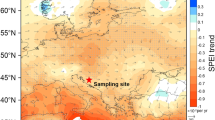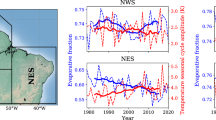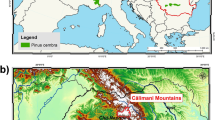Abstract
The vapor pressure deficit reflects the difference between how much moisture the atmosphere could and actually does hold, a factor that fundamentally affects evapotranspiration, ecosystem functioning, and vegetation carbon uptake. Its spatial variability and long-term trends under natural versus human-influenced climate are poorly known despite being essential for predicting future effects on natural ecosystems and human societies such as crop yield, wildfires, and health. Here we combine regionally distinct reconstructions of pre-industrial summer vapor pressure deficit variability from Europe’s largest oxygen-isotope network of tree-ring cellulose with observational records and Earth system model simulations with and without human forcing included. We demonstrate that an intensification of atmospheric drying during the recent decades across different European target regions is unprecedented in a pre-industrial context and that it is attributed to human influence with more than 98% probability. The magnitude of this trend is largest in Western and Central Europe, the Alps and Pyrenees region, and the smallest in southern Fennoscandia. In view of the extreme drought and compound events of the recent years, further atmospheric drying poses an enhanced risk to vegetation, specifically in the densely populated areas of the European temperate lowlands.
This is a preview of subscription content, access via your institution
Access options
Access Nature and 54 other Nature Portfolio journals
Get Nature+, our best-value online-access subscription
$29.99 / 30 days
cancel any time
Subscribe to this journal
Receive 12 print issues and online access
$259.00 per year
only $21.58 per issue
Buy this article
- Purchase on Springer Link
- Instant access to full article PDF
Prices may be subject to local taxes which are calculated during checkout




Similar content being viewed by others
Data availability
All raw tree-ring δ18O chronologies used in this study together with the final summer VPD reconstructions can be downloaded at the NOAA National Centre for Environmental Information (NCEI): https://www.ncei.noaa.gov/access/paleo-search/study/38660.
The CMIP6 data used in this study are available at https://esgf-node.llnl.gov/search/cmip6/. Detailed inputs for the search query are as follows: source IDs are ACCESS-ESM1-5, CESM2, CMCC-ESM2, CNRM-ESM2-1, CanESM5, EC-Earth3-Veg, GFDL-ESM4, IPSL-CM6A-LR, MIROC-ES2L, MPI-ESM1-2-LR, MRI-ESM2-0, and UKESM1-0-LL; experiment IDs are piControl, historical and ssp245, also hist-nat and hist-noLu; variant label is r1i1p1f1 or the next lowest number if unavailable for some models; frequency is mon; and variables are tas and hurs.
Code availability
R-codes used for fuzzy cluster and principal component analysis are available at https://github.com/Treydte/code_NGeo23, and python-codes for site-based monthly and seasonal correlations with climate variables are available at https://github.com/andreaskessler/VPDSeasonalCorr.
References
Bohren, C. F., Albrecht, B. A. & Schroeder, D. V. Atmospheric thermodynamics. Am. J. Phys. 68, 1159–1160 (2000).
Douville, H et al. in Climate Change 2021: The Physical Science Basis (eds Masson-Delmotte, V. et al.) 1055–1210 (Cambridge Univ. Press, 2021).
Seneviratne, S. I. et al. in Climate Change 2021: The Physical Science Basis (eds Masson-Delmotte, V. et al.) 1513–1766 (Cambridge Univ. Press, 2021).
Seneviratne, S. I. et al. Investigating soil moisture-climate interactions in a changing climate: a review. Earth Sci. Rev. 99, 125–161 (2010).
Grossiord, C. et al. Plant responses to rising vapor pressure deficit. N. Phytol. 226, 1550–1566 (2020).
Hsiao, J. et al. Maize yield under a changing climate: the hidden role of vapor pressure deficit. Agric. Meteorol. 279, 107692 (2019).
Ranasinghe, R. et al. in Climate Change 2021: The Physical Science Basis (eds Masson-Delmotte, V. et al.) 1767–1926 (Cambridge Univ. Press, 2021).
Yuan, W. et al. Increased atmospheric vapor pressure deficit reduces global vegetation growth. Sci. Adv. 5, eaax1396 (2019).
Miralles, D. G., Gentine, P., Seneviratne, S. I. & Teuling, A. J. Land–atmospheric feedbacks during droughts and heatwaves: state of the science and current challenges. Ann. N. Y. Acad. Sci. 1436, 19–35 (2019).
Ficklin, D. L. & Novick, K. A. Historic and projected changes in vapor pressure deficit suggest a continental-scale drying of the United States atmosphere. J. Geophys. Res. Atm. 122, 2061–2079 (2017).
Humphrey, V. et al. Soil moisture–atmosphere feedback dominates land carbon uptake variability. Nature 592, 65–69 (2021).
Fu, Z. et al. Atmospheric dryness reduces photosynthesis along a large range of soil water deficits. Nat. Commun. https://doi.org/10.1038/s41467-022-28652-7 (2022).
Breshears, D. D. et al. The critical amplifying role of increasing atmospheric moisture demand on tree mortality and regional die-off. Front. Plant Sci. 4, 266 (2013).
Clarke, H. et al. Forest fire threatens global carbon sinks and population centres under rising atmospheric water demand. Nat. Commun. https://doi.org/10.1038/s41467-022-34966-3 (2022).
Büntgen, U. et al. Recent European drought extremes beyond Common Era background variability. Nat. Geosci. https://doi.org/10.1038/s41561-021-00698-0 (2021).
Treydte, K. et al. Signal strength and climate calibration in a European tree-ring isotope network. Geophys. Res. Lett. 34, L24302 (2007).
Treydte, K. et al. Impact of climate and CO2 on a millennium-long tree-ring carbon isotope record. Geochim. Cosmochim. Acta 73, 4635–4647 (2009).
McCarroll, D. et al. Correction of tree ring stable carbon isotope chronologies for changes in the carbon dioxide content of the atmosphere. Geochim. Cosmochim. Acta 73, 1539–1547 (2009).
Klesse, S. et al. Oxygen isotopes in tree rings are less sensitive to tree size and stand dynamics than carbon isotopes. Plant Cell Environ. 41, 2899–2914 (2018).
Young, G. H. F. et al. Age trends in tree ring growth and isotopic archives: a case study of Pinus sylvestris L. from northwestern Norway. Glob. Biogeochem. Cycles https://doi.org/10.1029/2010GB003913 (2011).
Duffy, J. E. et al. Absence of age-related trends in stable oxygen isotope ratios from oak tree rings. Glob. Biogeochem. Cycles 33, 841–848 (2019).
Büntgen, U. et al. No evidence of age trends in oak stable isotopes. Paleooceanogr. Paleoclimatol. https://doi.org/10.1029/2019PA003831 (2020).
Gessler, A. et al. Stable isotopes in tree rings—toward a mechanistic understanding of isotope fractionation and mixing processes from the leaves to the wood. Tree Physiol. https://doi.org/10.1093/treephys/tpu040 (2014).
Treydte, K. et al. Seasonal transfer of oxygen isotopes from precipitation and soil to the tree ring: Source water versus leaf water enrichment. N. Phytol. 202, 772–783 (2014).
Sternberg, L., Pinzon, M. C., Anderson, W. T. & Jahren, A. H. Variation in oxygen isotope fractionation during cellulose synthesis: intramolecular and biosynthetic effects. Plant Cell Environ. 29, 1881–1889 (2006).
Martíınez-Sancho, E. et al. Unenriched xylem water contribution to cellulose synthesis influenced by atmospheric demand governs the intra-annual tree-ring d18O signature. New Phyt. 240, 1743–1757 (2023).
Levesque, M. et al. Tree-ring isotopes capture interannual vegetation productivity dynamics at the biome scale. Nat. Commun. 10, 742 (2019).
Daux, V. et al. Comparisons of the performance of δ13C and δ18O of Fagus sylvatica, Pinus sylvestris, and Quercus petraea in the record of past climate variations. J. Geophys. Res. Biogeosci. 123, 1145–1160 (2018).
Vitali, V. et al. High-frequency stable isotope signals in uneven-aged forests as proxy for physiological responses to climate in Western Europe. Tree Physiol. 41, 2046–2062 (2021).
Naulier, M. et al. A millennial summer temperature reconstruction for northeastern Canada using oxygen isotopes in subfossil trees. Clim. Past 11, 1153–1164 (2015).
Field, R. D. et al. Tree-ring cellulose δ18O records similar large-scale climate influences as precipitation δ18O in the Northwest Territories of Canada. Clim. Dyn. 58, 759–776 (2022).
Padrón, R. S. et al. Observed changes in dry-season water availability attributed to human-induced climate change. Nat. Geosci. 13, 477–481 (2020).
Eyring, V. et al. Overview of the Coupled Model Intercomparison Project Phase 6 (CMIP6) experimental design and organization. Geosci. Model Dev. 9, 1937–1958 (2016).
Dorado-Liñán, I. et al. Jet stream position explains regional anomalies in European beech forest productivity and tree growth. Nat. Commun. 13, 2015 (2022).
Trouet, V., Babst, F. & Meko, M. Recent enhanced high-summer North Atlantic Jet variability emerges from three-century context. Nat. Commun. 9, 180 (2018).
Luterbacher, J., Dietrich, D., Xoplaki, E., Grosjean, M. & Wanner, H. European seasonal and annual temperature variability, trends, and extremes since 1500. Science 303, 1499–1503 (2004).
Derham, W. The history of the great frost in the last winter 1703 and 1708/9. Phil. Trans. 26, 454–478 (1709).
Vicente-Serrano, S. M. et al. Recent changes of relative humidity: regional connections with land and ocean processes. Earth Syst. Dyn. 9, 915–937 (2018).
Sherwood, S. & Fu, Q. A drier future? Science 343, 737–739 (2014).
McDowell, N. G. et al. Mechanisms of woody-plant mortality under rising drought, CO2 and vapour pressure deficit. Nat. Rev. Earth Environ. https://doi.org/10.1038/s43017-022-00272-1 (2022).
Still, C. J. et al. No evidence of canopy-scale leaf thermoregulation to cool leaves below air temperature across a range of forest ecosystems. Proc. Natl Acad. Sci. USA https://doi.org/10.1073/pnas.2205682119 (2022).
Lansu, E. M., van Heerwaarden, C. C., Stegehuis, A. I. & Teuling, A. J. Atmospheric aridity and apparent soil moisture drought in European forests during heat waves. Geophys. Res. Lett. 47, e2020GL087091 (2020).
Zhao, M., Geruo, A., Liu, Y. & Kronings, A. G. Evapotranspiration frequently increases during droughts. Nat. Clim. Change 12, 1024–1030 (2022).
Vicente-Serrano, S. M., McVicar, T. R., Miralles, D. G., Yang, Y. & Tomas-Burguera, M. Unraveling the influence of atmospheric evaporative demand on drought and its response to climate change. Wiley Interdiscip. Rev. Clim. Change https://doi.org/10.1002/wcc.632 (2020).
Li, S. et al. Attribution of global evapotranspiration trends based on the Budyko framework. Hydrol. Earth Syst. Sci. 26, 3691–3707 (2022).
Novick, K. A. et al. The increasing importance of atmospheric demand for ecosystem water and carbon fluxes. Nat. Clim. Change 6, 1023 (2016).
Babst, F. et al. Twentieth century redistribution in climatic drivers of global tree growth. Sci. Adv. 5, eaat4313 (2019).
Trotsiuk, V. et al. Tree growth in Switzerland is increasingly constrained by rising evaporative demand. J. Ecol. 1.09, 2981–2990 (2021).
Zhang, Q. et al. Response of ecosystem intrinsic water use efficiency and gross primary productivity to rising vapor pressure deficit. Environ. Res. Lett. 14, 074023 (2019).
Allen, C. D., Breshears, D. D. & McDowell, N. G. On underestimation of global vulnerability to tree mortality and forest die-off from hotter drought in the Anthropocene. Ecosphere 6, 1–55 (2015).
de Dios, V. R. et al. Climate change induced declines in fuel moisture may turn currently fire-free Pyrenean mountain forests into fire-prone ecosystems. STOTEN 797, 149104 (2021).
Labuhn, I. et al. French summer droughts since 1326 CE: a reconstruction based on tree ring cellulose. Clim. Past 12, 1101–1117 (2016).
Konter, O. et al. Climate sensitivity and parameter coherency in annually resolved δ13C and δ18O from Pinus uncinata tree-ring data in the Spanish Pyrenees. Chem. Geol. 377, 12–19 (2014).
Boettger, T. et al. Wood cellulose preparation methods and mass spectrometric analyses of δ13C, δ18O, and nonexchangeable δ2H values in cellulose, sugar, and starch: an interlaboratory comparison. Anal. Chem. 79, 4603–4612 (2007).
Cook, E. R., Krusic, P. J., Peters, K. & Holmes, R. L. Program ARSTAN (version 49v1_Mac), autoregressive tree-ring standardization program (Tree–Ring Laboratory of Lamont–Doherty Earth Observatory, 2017).
Maechler, M., Rousseeuw, P., Struyf, A., Hubert, M. & Hornik, K. cluster: Cluster Analysis Basics and Extensions. R package version 2.1.3 https://CRAN.R-project.org/package=cluster (2022).
Kaufman, L., & Rousseeuw, P. J. Finding Groups in Data—An Introduction to Cluster Analysis (Wiley, 1990); https://doi.org/10.1002/9780470316801
Frank, D. C. & Esper, J. Temperature reconstructions and comparisons with instrumental data from a tree-ring network for the European Alps. Int. J. Clim. 25, 1437–1454 (2005).
Harris, I. et al. Version 4 of the CRU TS monthly high-resolution gridded multivariate climate dataset. Sci. Data 7, 109 (2020).
Murray, F. W. On the computation of saturation vapor pressure. J. Appl. Meteorol. 6, 203–204 (1967).
Grant, L. et al. Attribution of global lake systems change to anthropogenic forcing. Nat. Geosci. 14, 849–854 (2021).
Acknowledgements
We acknowledge the World Climate Research Programme’s Working Group on Coupled Modelling, which is responsible for the Coupled Model Intercomparison Project (CMIP), and we thank the climate modeling groups for producing their model output and making it available. For the CMIP, the US Department of Energy’s Program for Climate Model Diagnosis and Intercomparison provides coordinating support and led development of the software infrastructure in partnership with the Global Organization for Earth System Science Portals.
This study was funded by the EC projects ISONET EVK2-CT-2002-00147 and Millennium FP6-2004-GLOBAL-017008-2 and by the Swiss National Science Foundation (SNSF) projects iTREE CRSII3_136295 and TROXY 200021_175888. Other funding included ERC 724750 (AK), NASA’s Terrestrial Ecology programme (BP), Slovenian Research Agency P4-0107 (TL, PH), MIUR-PRIN 2002 2002075152 & MIUR-PRIN 2005 2005072877 (AS, LT), PALEOMEX-ISOMEX programme CNRS-INSU (VD), Fundació La Caixa through the Junior Leader Program LCF/BQ/LR18/11640004 (IDL), ERC 755865 & Academy of Finland 295319 and 343059 (KR-G), Czech Science Foundation CZ.02.1.01/0.0/0.0/16_019/0000797 (UB, JE), Spanish Ministry of Science and Technology REN2002-11476-E/CLI (EG), and ERC AdG 882727 (JE), UKRI EP/X025098/1 (NJL). L.L., R.P., and S.I.S. acknowledge support from the European Union’s Horizon 2020 Research and Innovation programme (grant agreement 821003 (4 C)). The views and conclusions contained in this document are those of the authors and should not be interpreted as representing the opinions or policies of the funding agencies and supporting institutions.
Author information
Authors and Affiliations
Contributions
K.T., L.L., R.P., F.B., D.C.F., A. Kahmen, S.I.S. and N.J.L. designed the research; K.T., L.L., R.P., F.B., D.C.F., E.M.-S., B.P. and R.W. performed the research with input from A.G., A. Kahmen, A. Kessler, A.I.S. and S.I.S. K.T. wrote the paper. All listed authors from L.A.-H. to G.Y. were involved in data production and provided feedback on the manuscript.
Corresponding author
Ethics declarations
Competing interests
The authors declare no competing interests.
Peer review
Peer review information
Nature Geoscience thanks William Lukens, Christopher Still and the other, anonymous, reviewer(s) for their contribution to the peer review of this work. Primary Handling Editor: James Super, in collaboration with the Nature Geoscience team.
Additional information
Publisher’s note Springer Nature remains neutral with regard to jurisdictional claims in published maps and institutional affiliations.
Extended data
Extended Data Fig. 1 Dependency of mean δ18O site values of the common period 1900-1994 on geographic location.
p-values below 0.05 indicate significant relationships.
Extended Data Fig. 2 Climate sensitivity of the site tree-ring δ18O chronologies in two independent time periods.
Periods cover 1920-1960 and 1961-2000; shorter for those records that end in 1994, 1996 and 1998, (see Extended Data Table 1). Colours indicate Pearson’s correlation coefficients calculated between each of the 45 site δ18O chronologies of the network and the closest gridpoints of VPD, maximum temperature (Tmax), precipitation sums and SPEI for each individual month from March of the year before to October of the actual year of tree-ring formation. For VPD and Tmax red colours indicate positive correlations, for PPT and SPEI red colours indicate negative correlations. Order of sites from North to South corresponds to the order in Extended Data Table 1.
Extended Data Fig. 3 Relationship between climate- δ18O correlations and geographic location for VPD, Tmax, precipitation (PPT) and SPEI in summer (June to August).
Each point indicates a correlation coefficient calculated between a site δ18O chronology and the closest gridpoint dataset, plotted as a function of latitude, longitude and elevation. Points above the dashed horizontal line are significant at P < 0.05. p-values in the legend indicate the significance of the slope of the linear regression line. Most p-values are above 0.05 which suggests independency of the correlation strength from geographical location. Note the inverse y-axis for PPT and SPEI.
Extended Data Fig. 4 Relationship between climate- d18O correlations and long-term means (period 1920-1994) of precipitation sums (PPT), SPEI, water balance (WAB), mean temperature (Tmean), maximum temperature (Tmax) and VPD.
Each point indicates a correlation coefficient calculated between a site δ18O chronology and the closest gridpoint climate dataset, plotted as a function of the nine selected climate long-term means (‘climatic regions’). R- and p-values in the legend indicate the significance of the relationship. Most p-values are above 0.05 which suggests independency of the correlation strength from the climatic region.
Extended Data Fig. 5 Contribution of the individual site chronologies to the common variance in the regional clusters of Northern Fennoscandia (NF), Southern Fennoscandia (SF), Western Europe (WE), Eastern Central Europe (ECE) and Alps & Pyrenees (AP).
Membership (%) the contribution to the common variance in a cluster in percentage. Mean rall is the mean inter-series correlation coefficient (that is, the common signal strength) of all chronologies contributing to the corresponding cluster, mean r>75 is the mean inter-series correlation of the chronologies with a membership >75% in a cluster (* P < 0.01, ** P < 0.001). Calculations are based on the period 1920-2000. Sites above a membership threshold of 75% (straight line) were used for the development of regional chronologies through nested principal component analysis. Site codes see Supplementary Table 1.
Supplementary information
Supplementary Information
Supplementary Results and Discussion, References, Tables 1–6 and Figs. 1–5.
Rights and permissions
Springer Nature or its licensor (e.g. a society or other partner) holds exclusive rights to this article under a publishing agreement with the author(s) or other rightsholder(s); author self-archiving of the accepted manuscript version of this article is solely governed by the terms of such publishing agreement and applicable law.
About this article
Cite this article
Treydte, K., Liu, L., Padrón, R.S. et al. Recent human-induced atmospheric drying across Europe unprecedented in the last 400 years. Nat. Geosci. 17, 58–65 (2024). https://doi.org/10.1038/s41561-023-01335-8
Received:
Accepted:
Published:
Issue Date:
DOI: https://doi.org/10.1038/s41561-023-01335-8



